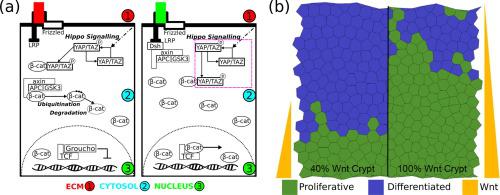Computational and Structural Biotechnology Journal ( IF 6 ) Pub Date : 2020-01-10 , DOI: 10.1016/j.csbj.2019.12.015 Daniel Ward , Sandra Montes Olivas , Alexander Fletcher , Martin Homer , Lucia Marucci

|
Intestinal crypts are responsible for the total cell renewal of the lining of the intestines; this turnover is governed by the interplay between signalling pathways and the cell cycle. The role of Wnt signalling in cell proliferation and differentiation in the intestinal crypt has been extensively studied, with increased signalling found towards the lower regions of the crypt. Recent studies have shown that the Wnt signalling gradient found within the crypt may arise as a result of division-based spreading from a Wnt ‘reservoir’ at the crypt base. The discovery of the Hippo pathway’s involvement in maintaining crypt homeostasis is more recent; a mechanistic understanding of Hippo pathway dynamics, and its possible cross-talk with the Wnt pathway, remains lacking. To explore how the interplay between these pathways may control crypt homeostasis, we extended an ordinary differential equation model of the Wnt signalling pathway to include a phenomenological description of Hippo signalling in single cells, and then coupled it to a cell-based description of cell movement, proliferation and contact inhibition in agent-based simulations. Furthermore, we compared an imposed Wnt gradient with a division-based Wnt gradient model. Our results suggest that Hippo signalling affects the Wnt pathway by reducing the presence of free cytoplasmic β-catenin, causing cell cycle arrest. We also show that a division-based spreading of Wnt can form a Wnt gradient, resulting in proliferative dynamics comparable to imposed-gradient models. Finally, a simulated APC double mutant, with misregulated Wnt and Hippo signalling activity, is predicted to cause monoclonal conversion of the crypt.
中文翻译:

肠道隐窝中Hippo和Wnt信号通路之间的串扰:基于代理的模型的见解
肠隐窝负责肠壁的总细胞更新。这种更新受信号传导途径与细胞周期之间相互作用的支配。Wnt信号在肠隐窝细胞增殖和分化中的作用已得到广泛研究,发现向隐窝下部区域的信号增多。最近的研究表明,在隐窝中发现的Wnt信号梯度可能是由于隐窝基部Wnt“储层”基于分区的扩散而产生的。河马途径参与维持隐窝稳态的发现是最近的。仍然缺乏对Hippo途径动力学及其与Wnt途径可能发生的串扰的机械理解。要探索这些途径之间的相互作用如何控制隐窝稳态,我们扩展了Wnt信号通路的普通微分方程模型,以包含单细胞中Hippo信号的现象学描述,然后将其与基于细胞的运动,增殖和接触抑制的基于细胞的描述相结合,并进行基于代理的模拟。此外,我们将强加的Wnt梯度与基于除法的Wnt梯度模型进行了比较。我们的结果表明,河马信号传导通过减少游离细胞质β-连环蛋白的存在而影响Wnt途径,从而导致细胞周期停滞。我们还表明,基于除数的Wnt扩散可以形成Wnt梯度,从而导致扩散动力学可与强加梯度模型相媲美。最后,预计模拟的APC双突变体具有错误调节的Wnt和Hippo信号传导活性,可引起隐窝的单克隆转化。



























 京公网安备 11010802027423号
京公网安备 11010802027423号